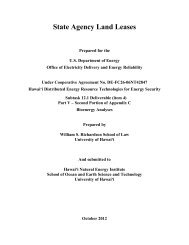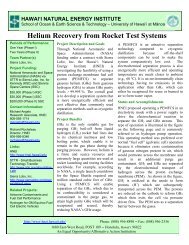Oahu Wind Integration Study - Hawaii Natural Energy Institute ...
Oahu Wind Integration Study - Hawaii Natural Energy Institute ...
Oahu Wind Integration Study - Hawaii Natural Energy Institute ...
You also want an ePaper? Increase the reach of your titles
YUMPU automatically turns print PDFs into web optimized ePapers that Google loves.
decisions). The commitment of units is the selection of units, a day or week in advance, which<br />
must operate in the future hour of interest. The dispatch of units is the power output of these<br />
committed units in a given hour required to meet the load at that instant. The commitment and<br />
dispatch decision depends on many variables, including the cost of each generator, the<br />
capabilities of the transmission system, and startup constraints on cycling units, as an example.<br />
The model includes representation of the HECO transmission system and relevant characteristics<br />
of each generating unit, such as the maximum and minimum power output, heat rate (thermal<br />
efficiency) as a function of production level, emissions, minimum downtime between starts,<br />
start-up costs, operating constraints, and maintenance and forced outages.<br />
Production cost modeling of the HECO system was performed with the GE’s Multi Area<br />
Production Simulation (MAPS TM ) software program. This commercially available modeling tool<br />
has a long history of governmental, regulatory, independent system operator and investor-owned<br />
utility applications. This tool was used to simulate the HECO production for 2007 as part of the<br />
baseline model validation process. Later, the model was used to forecast the <strong>Oahu</strong> power system<br />
for the year 2014. Ultimately, the production cost model provides the unit-by-unit production<br />
output (MW) on an hourly basis for an entire year of production (GWh of electricity production<br />
by each unit). The results also provide information about the variable cost of electricity<br />
production, emissions, fuel consumption, etc.<br />
The overall simulation algorithm is based on standard least marginal cost operating practice.<br />
That is, generating units that can supply power at lower marginal cost of production are<br />
committed and dispatched before units with higher marginal cost of generation. Commitment<br />
and dispatch are constrained by physical limitations of the system, such as transmission thermal<br />
limits, minimum spinning reserve, stability limits, as well as the physical limitations and<br />
characteristics of the power plants. Significant input was received from HECO and multiple<br />
model refinement iterations were performed in order to capture the nuances of the HECO<br />
system.<br />
The price that HECO pays to an independent power producer (IPP) for energy is not, in general,<br />
equal to the cost of production for the individual unit, nor are they equal to the systemic marginal<br />
cost of production. Rather, they are governed by power purchase agreements (PPAs). The price<br />
that HECO pays to IPPs for energy purchase was reflected in the simulation results insofar as the<br />
conditions of the PPAs can be reproduced. This was done in conjunction with the HECO team<br />
by modeling the AES and Kalaeloa units based on heat rate curves that reflect the cost of their<br />
production. The costs of purchasing power from HPower (today and in the future), Honua<br />
(future), and OTEC (future) were not captured in the model.<br />
The primary source of model uncertainty and error for production cost simulations, based on the<br />
model, consist of:<br />
o Minimum spinning reserve rules are included. Losses are considered in prioritizing<br />
dispatch. Each of these types of constraints in the model may be somewhat simpler than<br />
the precise situation dependent rules used by HECO.<br />
o Marginal production-cost models consider heat rate and a variable O&M cost. However,<br />
the models do not include an explicit heat-rate penalty or an O&M penalty for increased<br />
48




